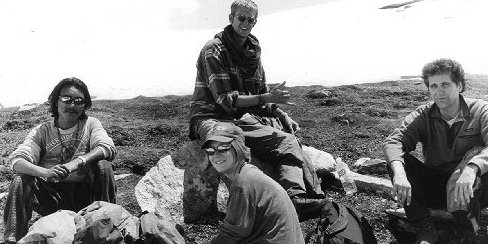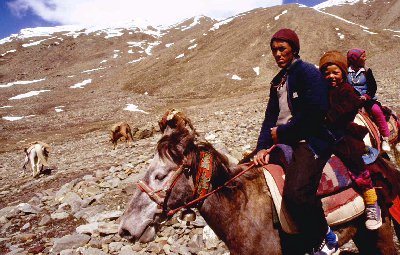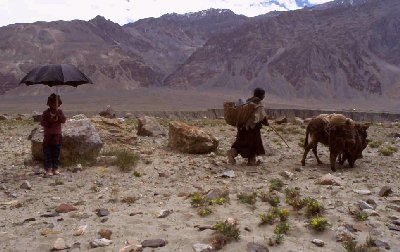



Travel
India - Trek to Leh
After the sights of Delhi it was good to escape to the hill station of Manali. A more relaxed and less crowded atmosphere all together.Zodiac Café
Just below the "Dope is Illegal" sign you’ll find the chillom being circulated. Begging at the tables will be plump Rupert the family dog. The cheese is delivered by an ex Italian-Swiss. A wild man who, if you can interpret, is also strongly involved in the fight against prohibition. But best of all is the English breakfast, perfect for putting on a few pounds.Rickshaws
Run down by a cycleshaw in manali, sandwiched between pedal rickshaws in Varanassi. These Baja cycleshaws (motorised) are a law unto themselves. Leaving the Zodiac one day we ran into a mini traffic jam which required ‘Indian Order from Chaos’. The little street to the public baths had become crammed with cycleshaws in the square and down the hill. The road being narrow for two cycleshaws to pass, this made it impossible to get back out. But with lots of shouting and hand waving they were syphoned down driveways, onto the sidewalk, and up dead-end alleys and slowly they all shuffled down again.Trek
A French-Canadian (Jean-Michelle) that Chad met managed to convince a trekking agency to take a group to Leh, earlier than ever before attempted. It looks as though we are along for the ride, only one hurdle could stop us- Shingo La of which there had been no reports of a crossing this season. 22 days, 4 helpers, 9 horses; this sounds serious Mum.June 8: Manali - Keylong (Rotang Pass)

Rotang pass proved relatively straight forward; a jeep ride up most of the way and a short walk over the snowed in section. Rotang is the name for "Place to die"; apparently Gengis Khan lost 250,000 people in blizzards here while attempting to invade India. On reaching the tea-house on the far side we realised we missed the bus to Darcha by a few minutes. It looks as though we will be stopping in Keylong.
June 9: Keylong - Darcha (The Paranoid Lama)

After taking a small aclimatisation walk up to Karding Monastry JM started talking to a Croatian Lama in the robes of the Dali Lama. He apparently living in the area for 4 years. He had come to the conclusion that Keylong and the two neighboring valleys were ‘evil’. He seemed to detest the polyandrous society and the selling of ‘Garbage Food’ to tourists.
Even our guide Karma seemed a little strange about the people of Keylong and was glad to leave the village. Darcha is really a very small village on the river valley we would be following. The night was spent in what looked more like a garage due to the roller door and lack of windows.
June 10: Darcha - Palimo

Our first day of walking but we are still managing to have the required number of smoko breaks for a non-teahouse trek. After lunch we ran into some sheep/goat drovers. They had brought 450 head from Dharamasala; we were on our 2nd day, they were on there 32nd day. Feeling humbled we sat for tea and a puff of the hooka.
June 11: Palimo - Sagasando (Three Ways)
A short day again (this is making Jean-Michelle nervous, he has a plane to meet in Leh), only 4 hours walking. We passed some yak herders who had been camped for 10 days waiting for Shingo to open. Another guy seems to be a friend of Karma - the story goes they crossed the pass together last season. We stopped just before a bridge where the path crosses the river to follow an impressive looking gorge east. A group of Nepalis raced past us continued on.June 12: Sagasando - Ramjak
The stone bridge that, from afar, looked as strong as anything in Nepal did not hold up to closer inspection. The horses would not cross over this under any circumstances so they had to be unloaded for them to swim across. By 11:30 the clouds had rolled in and we had to make camp before the snow hit, another short day to worry JM.June 13: Ramjak - Chiminokpo
 The
landscape now is very desolate; rocky, muddy and featureless, but from
this point we will be able to make an early assault on the pass. We met
a family with a small child crossing with horses from the other side who
confirmed that the trader and his wife we camped with the night before
had passed over. This was a good sign for us. The feared Zanskari and their
dZou meandered past just before dark and made camp. Tenzing and Bir (the
horsemen) kept a vigilant watch just in case.
The
landscape now is very desolate; rocky, muddy and featureless, but from
this point we will be able to make an early assault on the pass. We met
a family with a small child crossing with horses from the other side who
confirmed that the trader and his wife we camped with the night before
had passed over. This was a good sign for us. The feared Zanskari and their
dZou meandered past just before dark and made camp. Tenzing and Bir (the
horsemen) kept a vigilant watch just in case.
June 14: Chiminokpo - Shingo La - Lakong (Godess House)
We were actually meant to start at 4:00am but none of our trusty guides had a watch that worked. Consequently you Karma woke us at 1:00am to the bitter cold. We did manage to get away at about 3:30am. Shingo is a river pass from this side and has several false peaks but once you come to a sheere ice wall it is not far to the top. Darbu, one of the horses, punctured the flesh in its breast after slipping on rocks and I think all the horse had a rough time. We stopped at the top to make the appropriate offerings and string up JM’s prayer flags that bore the party’s names. Then it was a quick descent into the Zanskar Valley.June 15: Lakong - Key
 Key
overlooks Gumburanjan Mountain. We passed right below its impressive face
today but I failed to see the mythical gompa atop; perhaps my heart was
not as pure as I've led myself to believe. The barren valley walls are
many colours: reds, fawns, blacks, and grays. Watch out for the camping
charge here though.
Key
overlooks Gumburanjan Mountain. We passed right below its impressive face
today but I failed to see the mythical gompa atop; perhaps my heart was
not as pure as I've led myself to believe. The barren valley walls are
many colours: reds, fawns, blacks, and grays. Watch out for the camping
charge here though.
June 16: Key - Jal
My first day of illness (I think I must have caught a flu of some sort). The stupas and prayer walls are coming thick and fast now. The kids have a new mantra in this valley "Hello Bonbon", we can thank some French travelers for that, even the grandmothers get into the act. Doctors Tenzing and Karma have prescribed salt rice pudding for me and plenty of water.June 17: Jal - Phuktal Monastry - Chha
More salt rice pudding (I hope I’m well soon) but I slept well. Phuktal is a side trip down a tributary and appears suddenly as you round a corner. No one can truly tell you how old this place is, 500 or even 2000 years, but its history is very colourful. Stories of raiders, murder and the single tree that grows atop the monastry. The lamas here are all young, apparently the older ones are away teaching. We tried the path on the other side of the valley to return up the river into Chha. An narrow track in most places, non-existent in others.June 18: Chha - Pepula
We drank chang (tsampa beer) with Karma and a shopkeeper’s family last night, and Karma told Tibetan stories. At about lunch time we had pitched camp and a solo Australian, Hugh, came walking in. He had been trekking in Kashmir and was now on his way to Phuktal from Padam. He was carrying all his own food (23kgs) but his stove had broken. JM and Tenzing came to the rescue and managed to get it working.June 19: Pepula - Reru
Tenzing came down with the antlers of an Ibex this morning, a mere 20kg. Mara seems to be having trouble with her knee but Doctor Karma is using a little mutton fat to fix her up. Reru is a pretty little town with schools bursting with kids.June 20: Reru - Padum
 Padum
is the capital of the Zanskar region and typical of capitals the road to
it is being widened. Tenzing has bought some moth balls to kill the maggots
in Darbu’s wound. There is a bus out here but everyone is still keen to
keep going. But this is the business half of the trek, with almost a pass
a day to conquer.
Padum
is the capital of the Zanskar region and typical of capitals the road to
it is being widened. Tenzing has bought some moth balls to kill the maggots
in Darbu’s wound. There is a bus out here but everyone is still keen to
keep going. But this is the business half of the trek, with almost a pass
a day to conquer.
June 21: Padum - Karcha
Padum is situated in a huge valley where two mighty rivers meet. This valley has the appearance of a mighty crater and all about the sides are villages which must be situated just above the high tide mark. Another river to cross this time the horse had to use the bridge and only with a lot of coaxing. Then to Karcha and another monastry to investigate. It appeared to be quite impressive but again mostly deserted with the lamas off on missionary work.June 22: Karcha - Pishu
The story of Pishu goes that once a Lama entered the town and asked for food for several days like a Baba or holy man. He told them that when he died that they should burn his body ontop of the mountain overlooking the village, instead he was cremated near the river. From that very spot a spring began, so the lazy people did not have a spring run through their town. A dust storm blew through the village at about 4. The dark clouds that gathered on the skyline looked like rain and then the wind swung back around to the south.June 23: Pishu - Hanumil
Another day of winding through this barren valley. The rocky slopes decked in grays, reds and golds provide a viewing bonanza. Just before Padmu you rise up onto a plateau and see in the distance a solitary stupa, it is not until you are almost on top of it do you see the water-course sunken deep into the plateau, and the village on the other bank. The folding rock formations are a geologists dream here.June 24: Hanumil - Purfi La - Snertse (3900m)
Hello Ladak, you sonofabitch! The climb to Pufi La was gradual and quite pleasant. Then there is a steep descent to a river that apparently marks the boundary between Ladakh and Zanskar. Then you must climb the other side of this valley which is just as steep as the descent, then a gradual down to the camping site.June 25: Snertse - Hanuma La - Lingshad (3800m)
The trail to the pass was gradual up a small river passing between undulating golden soil hills. But when you reach the top of Hanuma La the view is simply breath taking on the other side, with mountains as far as the eye can see, this was one of the highlight of the trek. Although we could then see Lingshad there was not a direct route into the village. We traced a large circle flanking it to avoid the river crossings to finally arrive at Lingshad.The Dali Lama was apparently on his way so the local community was blasting a helipad. With a little onomatopoeia we got the general idea that it would not be good to stay so close to the site. Chad and I went to check out the Gompa and JM and Mara took shelter, then there was a huge blast which sent fragments as far a the gompa and Mara detailed the close call that some of our tents had.
June 26: Lingshad - Kubu La - Singe Base Camp (3800m)
The was first a small pass of Morgum La (4100m) but we were already camped most of the way up and then it was a few gentle up and downs to the village of Gongma. We then all looked on in disbelief at the nasty switch backs up what we feared was Kuba La and we still had to go down first. Kuba La was a nasty 1 hour climb almost straight up. We the followed the aqueduct to the base of Shinge La.June 27: Singe La - Photaskar (5060m)
The top of Singe La came a bit of a surprise, I was expecting at least one false peak. There was even snow on the lea side, the first since Rotang. There were plenty of marmuts around this area and young Karma tried to bag himself a fur hat but is a too little slow. Another pass, Bodmitse La (4200m) but not a difficult climb.June 28: Photaskar - Sirsir La - Hanupatta (4805m)
My feeling of ‘death warmed up’ over the last few days has started to ease since I have crossed the last pass and started to get a little lower. But the general feeling is that it has been a long time in the mountains.June 29: Hanupata - Wanla
We now passing through a narrow gorge carved out of solid rock and over a few ancient bridges that don’t inspire much confidence. By the time we reach the village of Penjila for lunch we have already been walking on the road that is under construction; civilisation can not be to far away.There is a small gompa in Wanla, which is all that remains of a medieval fort. What it lacks in size (it is very ‘cosy’) it makes up in history. Built in the ruins of an old castle it still retains much of the old workmanship. The frescoes are faded and covered with years of candle soot, yet you can still make out the fine detail. There are 3 large statues that dominate the room, 2 being bottisattvas that lived in this gompa and the last is the deity representing the 14th Dali Lama. The gompa is said to be 2000 years old, I could probably believe that.
June 30: Wanla - Lamayuru
This was the end of the walk, there would be no camping after this. A short day and a small pass was all that remained. When we finally crossed the last pass and viewed the green and yellow tsampa fields of Lamayuru it was time for some celebrating. We spent the night in the monastry lodge and took a truck ride to Leh in the morning along the highest motorable road in the world.

